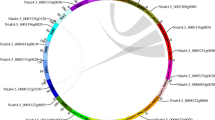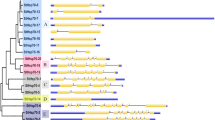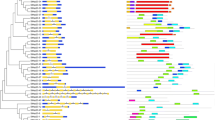Abstract
Heat shock proteins 70 (Hsp70) constitute a highly conserved protein family of cellular chaperones widely distributed in plants, where they play a fundamental role in response to biotic and abiotic stress. Until now, genome-wide analyses of the Hsp70 gene family have been conducted for some species. However, reports about Hsp70 genes in Nicotiana tabacum are scarce. In this study, we systematically conducted genome-wide identification and expression analysis of the Hsp70 gene family in tobacco, including gene structure, classification, evolutionary relationships, promoters, and transcript levels in response to abiotic stress treatments. In all, 61 Hsp70 members were identified and classified into six groups that were mapped onto 18 chromosomes, where most were distributed on both ends of the chromosome. The conserved structures and motifs of NtHsp70 proteins in the same subfamily were highly consistent. At least 15 pairs of NtHsp70 genes underwent gene duplication by segment and tandem duplications. Most NtHsp70 proteins contained N-terminal hexokinase conserved motifs. Phylogenetic analysis showed that most species expanded according to their own species-specific approach during the evolution of Hsp70s. Tissue-specific expression analysis indicated that all NtHsp70 genes were involved in at least one or more abiotic stress responses, highlighting the wide participation of NtHsp70 genes in environmental adaptation. This is the first genome-wide analysis of Hsp70 in N. tabacum. These results indicate that each NtHsp70 member fulfilled distinct functions in response to various abiotic stresses.




Similar content being viewed by others
Data availability
The data sets supporting the results of this article are included within the article and its additional file.
Abbreviations
- Hsp70:
-
Heat shock protein 70
- NtHsp70 :
-
Gene in Nicotiana tabacum
- ABA:
-
Abscisic acid
- PEG:
-
Polyethylene glycol
- qRT-PCR:
-
Quantitative real-time PCR
- Chlo:
-
Chloroplast
- Cyto:
-
Cytosol
- Endo:
-
Endoplasmic reticulum
- Mito:
-
Mitochondria
References
Wang W, Vinocur B, Shoseyov O, Altman A (2004) Role of plant heat-shock proteins and molecular chaperones in the abiotic stress response. Trends Plant Sci 9:244–252
Bailey-Serres J, Voesenek LACJ (2008) Flooding stress: acclimations and genetic diversity. Annu Rev Plant Biol 59:313–339
Ahuja I, Vos RC, Bones AM, Hall RD (2010) Plant molecular stress responses face climate change. Trends Plant Sci 15:664–674
Zhang L, Gao M, Hu J, Zhang X, Wang K, Ashraf M (2012) Modulation role of abscisic acid (ABA) on growth, water relations and glycinebetaine metabolism in two maize (Zea mays L.) cultivars under drought stress. Int J Mol Sci 13:3189–3202
Ritossa F (1962) A new puffing pattern induced by temperature shock and DNP in Drosophila. Experientia 18:571–573
Huang Y, Li M, Wang F, Xu Z, Huang W, Wang G, Ma J, Xiong A (2015) Heat shock factors in carrot: genome-wide identification, classification, and expression profiles response to abiotic stress. Mol Biol Rep 42:893–905
Eckl JM, Richter K (2013) Functions of the Hsp90 chaperone system: lifting client proteins to new heights. Int J Biochem Mol Biol 4:157
Timperio AM, Egidi MG, Zolla L (2008) Proteomics applied on plant abiotic stresses: role of heat shock proteins (HSP). J Proteomics 71:391–411
Mads D, Mikkel R, Marja JT (2007) The heat shock protein 70 family: highly homologous proteins with overlapping and distinct functions. Febs Lett 581:3702–3710
Large A, Goldberg M, Lund P (2009) Chaperones and protein folding in the archaea. Biochem Soc Trans 37:46–51
Dragovic Z, Broadley SA, Shomura Y, Bracher A, Hartl FU (2006) Molecular chaperones of the Hsp110 family act as nucleotide exchange factors of Hsp70s. Embo J 25:2519–2528
Garcia VM, Nillegoda NB, Bukau B, Morano KA (2017) Substrate binding by the yeast Hsp110 nucleotide exchange factor and molecular chaperone Sse1 is not obligate for its biological activities. Mol Biol Cell 28:2066–2075
Sarkar NK, Kundnani P, Grover A (2013) Functional analysis of Hsp70 superfamily proteins of rice (Oryza sativa). Cell Stress Chaperones 18:427–437
Lin B, Wang J, Liu H, Chen R, Meyer Y, Barakat A, Delseny M (2001) Genomic analysis of the Hsp70 superfamily in Arabidopsis thaliana. Cell Stress Chaperones 6:201
Guy CL, Li QB (1998) The organization and evolution of the spinach stress 70 molecular chaperone gene family. Plant Cell 10:539–556
Zhang Y, Wang M, Chen J, Rong J, Ding M (2014) Genome-wide analysis of HSP70 superfamily in Gossypium raimondii and the expression of orthologs in Gossypium hirsutum. Hereditas 36:921–933
Gromoff EDV, Schroda M, Oster U, Beck CF (2006) Identification of a plastid response element that acts as an enhancer within the Chlamydomonas HSP70A promoter. Nucleic Acids Res 34:4767–4779
Lin H, Han L, Blank M, Head M, Goodman R (2015) Magnetic field activation of protein-DNA binding. J Cell Biochem 70:297–303
Song J, Weng Q, Ma H, Yuan J, Wang L, Liu Y (2016) Cloning and expression analysis of the Hsp70 gene ZmERD2 in Zea mays. Biotechnol Biotechnol Equip 30:1–8
Su P, Li H (2010) Stromal Hsp70 is important for protein translocation into pea and Arabidopsis chloroplasts. Plant Cell 22:1516–1531
Cuimin L, Felix W, Golecki JR, Sabrina C, Barbara H, Christine M, Michael S (2010) The chloroplast HSP70B-CDJ2-CGE1 chaperones catalyse assembly and disassembly of VIPP1 oligomers in Chlamydomonas. Plant J Cell Mol Biol 50:265–277
Sung DY, Kaplan F, Guy CL (2010) Plant Hsp70 molecular chaperones: protein structure, gene family, expression and function. Physiol Plant 113:443–451
Noël LD, Cagna G, Stuttmann J, Wirthmüller L, Betsuyaku S, Witte CP, Bhat R, Pochon N, Colby T, Parker JE (2007) Interaction between SGT1 and cytosolic/nuclear HSC70 chaperones regulates Arabidopsis immune responses. Plant Cell 19:4061–4076
Sierro N, Battey JND, Ouadi S, Bakaher N, Bovet L, Willig A, Goepfert S, Peitsch MC, Ivanov NV (2014) The tobacco genome sequence and its comparison with those of tomato and potato. Nat Commun 5:3833
Finn RD, Coggill P, Eberhardt RY, Eddy SR, Mistry J, Mitchell AL, Potter SC, Punta M, Qureshi M, Sangradorvegas A (2016) The Pfam protein families database: towards a more sustainable future. Nucleic Acids Res 44:D279–D285
Wang Y, Tang H, Debarry JD, Tan X, Li J, Wang X, Lee T, Jin H, Marler B, Guo H (2012) MCScanX: a toolkit for detection and evolutionary analysis of gene synteny and collinearity. Nucleic Acids Res 40:e49–e49
Krzywinski M, Schein JI (2009) Circos: an information aesthetic for comparative genomics. Genome Res 19:1639–1645
Chenna R, Sugawara H, Koike T, Lopez R, Gibson TJ, Higgins DG, Thompson JD (2003) Multiple sequence alignment with the Clustal series of programs. Nucleic Acids Res 31:3497–3500
Tamura K, Stecher G, Peterson D, Filipski A, Kumar S (2013) MEGA6: molecular evolutionary genetics analysis version 6.0. Mol Biol Evol 30:2725–2729
Livak KJ, Schmittgen TD (2001) Analysis of relative gene expression data using real-time quantitative PCR and the 2(−Delta Delta C(T)) method. Methods 25:402–408
Mach J (2009) Alternative splicing produces a JAZ protein that is not broken down in response to jasmonic acid. Plant Cell 21:14–14
González-Díaz H, Pérez-Castillo Y, Podda G, Uriarte E (2007) Computational chemistry comparison of stable/nonstable protein mutants classification models based on 3D and topological indices. J Comput Chem 28:1990–1995
Yang Z, Zhou Y, Wang X, Gu S, Yu J, Liang G, Yan C, Xu C (2008) Genomewide comparative phylogenetic and molecular evolutionary analysis of tubby-like protein family in Arabidopsis, rice, and poplar. Genomics 92:246–253
Jain M, Tyagi AK, Khurana JP (2006) Genome-wide analysis, evolutionary expansion, and expression of early auxin-responsive SAUR gene family in rice (Oryza sativa). Genomics 88:360–371
Skolnick J, Fetrow JS (2000) From genes to protein structure and function: novel applications of computational approaches in the genomic era. Trends Biotechnol 18:34–39
Pettigrew DW (2009) Amino acid substitutions in the sugar kinase/hsp70/actin superfamily conserved ATPase core of E. coli glycerol kinase modulate allosteric ligand affinity but do not alter allosteric coupling. Arch Biochem Biophys 481:151–156
Bing L, Liu H, Sun D, Zhou R (2002) Signal transduction mechanism of plant heat shock response. Acta Photophysiol Sin 28:1–10
Tapia G, Verdugo I, Yañez M, Ahumada I, Theoduloz C, Cordero C, Poblete F, González E, Ruizlara S (2005) Involvement of ethylene in stress-induced expression of the TLC1.1 retrotransposon from Lycopersicon chilense Dun. Plant Physiol 138:2075–2086
Riboni M, Robustelli TA, Galbiati M, Tonelli C, Conti L (2016) ABA-dependent control of GIGANTEA signalling enables drought escape via up-regulation of FLOWERING LOCUST in Arabidopsis thaliana. J Exp Bot 67:6309–6322
Shah J, Klessig DF (2010) Identification of a salicylic acid-responsive element in the promoter of the tobacco pathogenesis-related beta-1,3-glucanase gene, PR-2d. Plant Journal 10:1089–1101
Mukhopadhyay I, Nazir A, Saxena DK, Chowdhuri DK (2003) Heat shock response: Hsp70 in environmental monitoring. J Biochem Mol Toxicol 17:249–254
Cazalé AC, Clément M, Chiarenza S, Roncato MA, Pochon N, Creff A, Marin E, Leonhardt N, Noël LD (2009) Altered expression of cytosolic/nuclear HSC70-1 molecular chaperone affects development and abiotic stress tolerance in Arabidopsis thaliana. J Exp Bot 60:2653–2664
Anderson JV, Guy CL (1995) Spinach leaf 70-kilodalton heat-shock cognate stabilizes bovine adrenal glucose-6-phosphate dehydrogenase in vitro without apparent stable binding. Planta 196:303–310
Guo M, Liu J, Ma X, Zhai Y, Gong Z, Lu M (2016) Genome-wide analysis of the Hsp70 family genes in pepper (Capsicum annuum L.) and functional identification of CaHsp70-2 involvement in heat stress. Plant Sci 252:246–256
Lee SC, Luan S (2011) ABA signal transduction at the crossroad of biotic and abiotic stress responses. Plant Cell Environ 35:53–60
Aleksandra W, Florina V, Sirichandra C, Yulia R, Fabien J, Christiane V, Nicolas-Freidit F, Jeffreya L (2008) An update on abscisic acid signaling in plants and more. Mol Plant 1:198–217
Fujita Y, Fujita M, Satoh R, Maruyama K, Parvez MM, Seki M, Hiratsu K, Ohme-Takagi M, Shinozaki K, Yamaguchi-Shinozaki K (2005) AREB1 is a transcription activator of novel ABRE-dependent ABA signaling that enhances drought stress tolerance in Arabidopsis. Plant Cell 17:3470–3488
Acknowledgements
We thank China National Tobacco Corp., Chongqing Division and Henan Agricultural University for financial support and technical assistance. We also appreciate the reviewers and editors for the patience to the work.
Funding
This work was supported by China National Tobacco Corp., Yunnan Division (2016YN10, 2017YN19) and China National Tobacco Corp., Chongqing Division (NY20180601070002).
Author information
Authors and Affiliations
Contributions
ZPS and FLP conceived and designed the experiments. XPL and DBW performed the experiments and participated to the data analysis. CY and BQZ performed the qRT-PCR experiments. HYZ revised the manuscript.
Corresponding author
Ethics declarations
Conflicts of interest
The authors declare that they have no conflicts of interest.
Additional information
Publisher’s Note
Springer Nature remains neutral with regard to jurisdictional claims in published maps and institutional affiliations.
Electronic supplementary material
Below is the link to the electronic supplementary material.
Rights and permissions
About this article
Cite this article
Song, Z., Pan, F., Lou, X. et al. Genome-wide identification and characterization of Hsp70 gene family in Nicotiana tabacum. Mol Biol Rep 46, 1941–1954 (2019). https://doi.org/10.1007/s11033-019-04644-7
Received:
Accepted:
Published:
Issue Date:
DOI: https://doi.org/10.1007/s11033-019-04644-7




